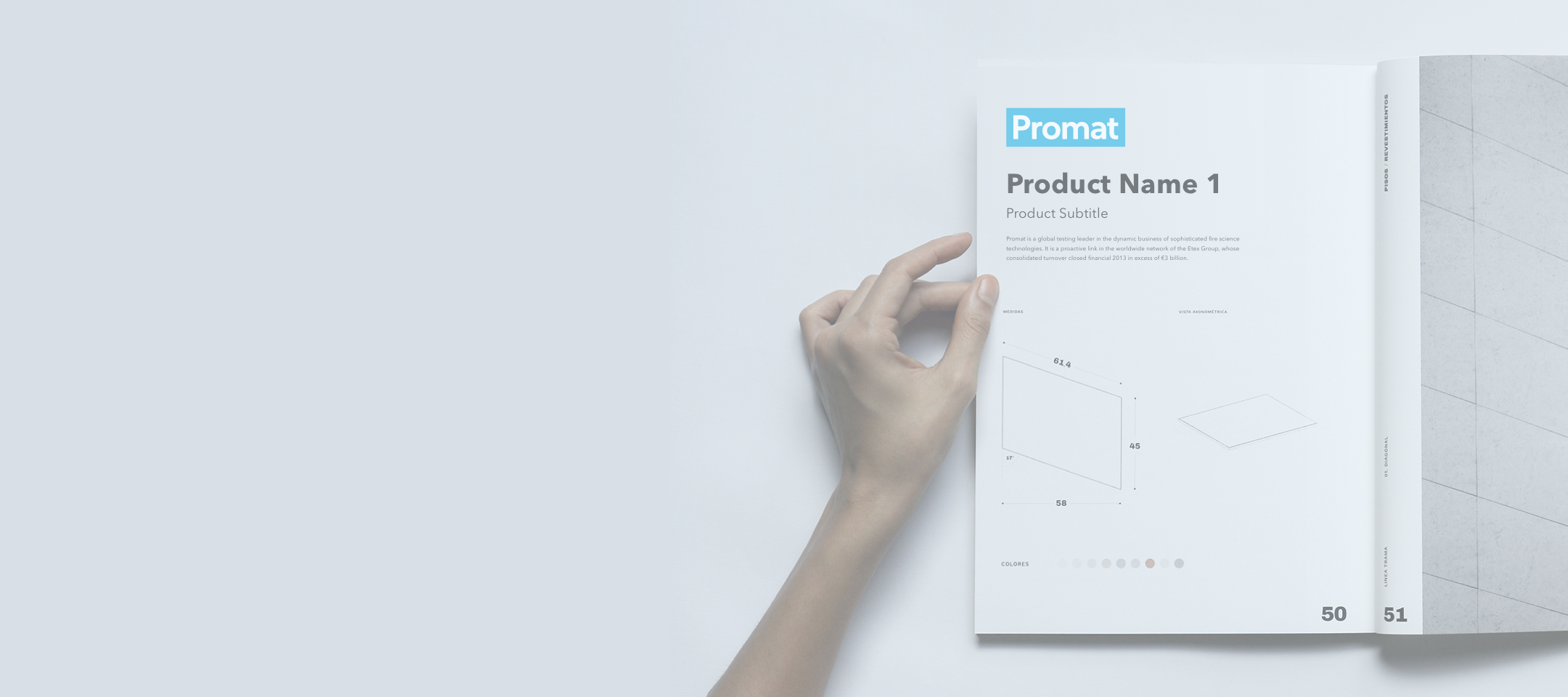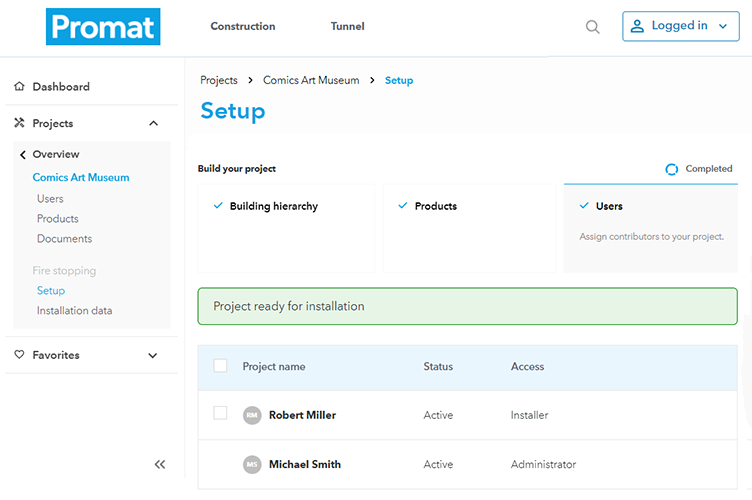
Como proteger a estrutura
Quando ocorre um incêndio, é fundamental dar aos ocupantes de um edifício tempo suficiente para evacuar para um local seguro e permitir que os bombeiros combatam o incêndio. É por isso que precisamos evitar que o prédio desmorone, mesmo que parcialmente, durante um incêndio.
Se pudermos evitar o colapso (parcial) do edifício, seremos capazes de limitar os danos ao edifício, bem como aos bens nele contidos. Na maioria dos casos, o conteúdo de um edifício representa um valor especial e insubstituível. Pense nos objetos com valor histórico ou emocional que você encontra em um museu ou biblioteca. Ou o equipamento de salvamento que é usado em um hospital. O dano vai muito além de uma perda financeira.
A Promat oferece uma gama completa de produtos de placa, spray e pintura, fornecendo soluções flexíveis para atender a uma variedade de necessidades de instalação e proteção contra incêndio para todos os materiais de construção comuns. Todos os produtos e sistemas Promat foram testados em laboratórios credenciados em todo o mundo em uma variedade de padrões, como AS1530.4, AS4100, AS3600, EN 13381 e EN 1365 series, BS 476: Parte 21, UL 263 e ASTM E119.

Proteção estrutural de aço
Quando o aço esquenta durante um incêndio, a estrutura perde gradualmente sua capacidade de carga em temperaturas entre 350oC e 750oC. Dependendo das cargas e ações na estrutura, ela normalmente falha quando o aço atinge temperaturas entre 500 e 600oC. Portanto, a proteção do aço estrutural é necessária para preservar a estabilidade da estrutura do edifício em caso de incêndio. A Promat oferece uma ampla gama de produtos de placa, spray e pintura para atender aos requisitos de qualquer projeto.
A espessura necessária de cada produto depende de:
• O requisito de resistência ao fogo (normalmente 60, 90 ou 120 minutos, às vezes até 180 ou 240 minutos, de acordo com a legislação nacional e principalmente dependendo da função e altura e das atividades no interior do edifício).
• A temperatura crítica do aço (normalmente 500-600oC e especificada nas regulamentações nacionais ou por engenheiros estruturais). Isso representa a temperatura máxima na qual o aço ainda tem resistência suficiente para evitar colapsos ou grandes deformações.
• A geometria e a orientação da estrutura de aço. Quanto mais grossos são os elementos de aço, mais lentamente eles aquecem. Os elementos mais finos aquecem mais rapidamente. Isso é expresso como um “fator de seção”, que normalmente é de 50-100 m-1 para seções pesadas espessas e 200-300 m-1 para seções finas e leves. O fator de seção também é influenciado pela exposição ao fogo, por ex. em três lados para uma viga, em quatro lados para uma coluna. Os testes por institutos independentes são sempre seguidos por uma avaliação, que resulta em tabelas que fornecem a espessura necessária para o produto em questão, dependendo do requisito de resistência ao fogo, temperatura crítica do aço, tipo de elemento, orientação e fator de seção.

Proteção estrutural de concreto
When concrete heats up during fire, at some point in time the steel reinforcement will heat up as well. The heating of the steel reinforcement is delayed by the concrete cover, since the thermal transfer through the concrete is relatively slow. Moreover, at temperatures in a range of roughly 200-800oC the concrete itself loses its loadbearing capacity because of internal micro-cracking and chemical transformation (dehydration) of the cement phase. Typically, design standards simplify this gradual strength loss by assuming a limiting temperature of 500oC for concrete.
For concrete structures in low-humidity environments and exposed to the standard (cellulosic) fire curve, most design codes accept that spalling will not occur. In case of more severe fire curves or exposure to humid environments, spalling of concrete could lead to the loss of cover within a short time, and this could result in an additional more stringent temperature requirement for the concrete surface itself, rather than for the steel reinforcement bar that is placed inside the concrete.
Whenever the concrete cover thickness is insufficient to keep the steel reinforcement temperatures low enough to avoid collapse, or when spalling of concrete could occur or when the concrete itself is deteriorated, fire protection is needed. Promat offers boards, sprays and paints that have been tested and assessed for columns, beams, walls and slabs. In case of a concrete structure that doesn’t spall, the required thickness of the product depends on the amount of lacking concrete cover on the steel reinforcement.
Testing by independent institutes is always followed by an assessment which specifies the performance of the fire protection product in terms of “equivalent thickness” and of adhesion and cohesion of the protective material. The equivalent thickness depends on the fire exposure of the element (single sided such as walls or slabs, or multi sided such as beams or columns) and on the fire resistance requirement.

Proteção contra fogo para estruturas mistas
When composite structures, typically consisting of a profiled steel deck with concrete cast on top, are exposed to fire from below, the steel deck will lose strength and potentially detach from the concrete. This will strongly reduce the loadbearing capacity of the composite deck.
In order to avoid such failure, the bottom side of the deck must be fire protected with sufficient thickness for the steel deck to retain its strength and adhesion to the concrete. Typically, a failure temperature of 350oC is used.
Promat offers boards, sprays and paints for the protection of composite slabs. The choice of protection system depends on fire resistance requirement, durability requirements and jobsite conditions.

Proteção estrutural de madeira
When timber heats up during fire, the material starts to burn at the surface, forming a layer of char. During the fire, the charred depth will gradually increase. The charred material has no strength left and also the pyrolysis zone (between the char and the still unburned wood) has a very limited mechanical resistance. Therefore, the remaining cross-section of the timber element gradually reduces, and at some point, the load can no longer be carried and the element will collapse.
The fire resistance can be improved by applying fire protection. This beneficial effect comes in two ways:
• The fire protection will delay the heating up of the timber, therefore postponing the start of the charring process
• Once the charring starts, the fire protection will slow down the speed of the charring (“charring rate”).
Promat offers board and paint products that have been tested and assessed by independent institutes. The assessment report states the time that the fire protection system delays the start of the charring, as well as the slowed down rate of charring that occurs during more prolonged fire exposure. With these data, the engineer can calculate the effectively remaining cross section of the timber element after a certain fire exposure and check that it is still able to carry the loads.





